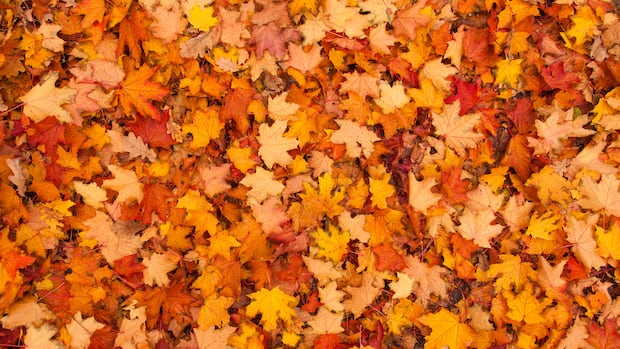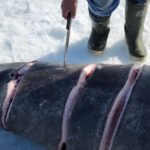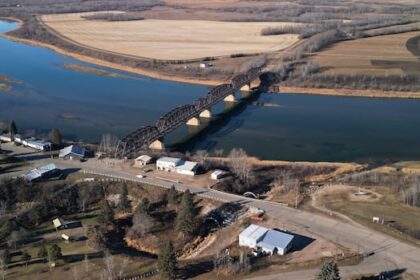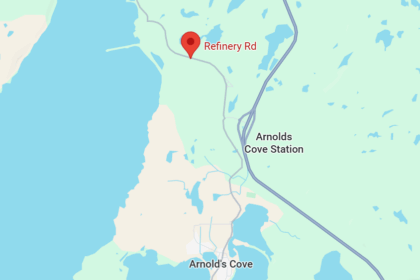(CBC)Welcome to our weekly newsletter where we highlight environmental trends and solutions that are moving us to a more sustainable world. Hi, it’s Nicole. We all love raking leaves, right? Yeah, I didn’t think so. So do we really need to? I take a look at why it might not be necessary.This week:To rake or not to rake?The Big Picture: Winning wildlife photoHow one company is making money – and jewelry – from abandoned mine sitesTo rake or not to rake?Fallen leaves can provide habitat for insects and more, but too many on your lawn isn’t a good thing. (Giovanni Love/Shutterstock )It’s that time of year again, where you can leave your bedroom window open at night and fall asleep with a cool breeze brushing across your face and listen to the sound of leaves rustling as you doze off.To be clear, these aren’t the leaves on the trees, but rather the dried up ones that have fallen as the season begins to transition to winter.Collecting all those leaves is a tedious and back-breaking job that a gust of wind could undo at any moment. As more people are looking to more natural gardens and lawns, should we be raking up the leaves at all?“As most things in science go, it depends,” said Sara Stricker, communications and outreach coordinator at the University of Guelph’s Turfgrass Institute.She noted that there is a campaign called Leave the Leaves, supported by the Xerces Society for Invertebrate Conservation. We may not notice it, but leaves provide habitat and shelter for insects, butterflies, moths, and even some birds.“So, the idea behind not raking your leaves is to leave ecosystems for insects to winter. And that is, on its front, correct,” Stricker said. But, she went on to say that Canadians are not very good at doing that: as soon as we see the first green shoots, we start mowing, fertilizing and gardening, celebrating the last of snow.Paul Zammit, a professor at Niagara College’s environment division, said that our understanding of how leaves contribute to ecosystems is constantly evolving, and that perhaps we should try to leave leaves on the ground.“Leaves are a source of organic matter that will break down and provide nutrients. But it is so much more than that,” he said. “What we have learned is that those leaves that fall to the ground also provide very important habitats for insects, amphibians, invertebrates, et cetera.”One of those creatures at this time of year is the wooly bear caterpillar, he said. Right now they’re looking for a pile of leaves or sticks that they can submerge themselves in so they can overwinter. If we are taking away those leaves, they are at risk.A wooly bear caterpillar. (Jason French/Shutterstock)Another thing to take into consideration, he noted, was that leaves also provide nutrition to your lawn.“”We’ve learned a lot about the value of leaves and the value of returning organic matter back into the soil,” he said. “What has nature been doing for millions of years? What have forest systems been doing? Trees take care of themselves by dropping their leaves,” he said. “Those leaves break down, and that becomes — I’m generalizing it here — a source of nutrition for the following years. It feeds the soil microbes.”But Stricker also noted that those leaves can also provide habitat for unwanted pests like mice or voles, which can create little tunnels on your lawn.There’s also the risk of suffocating your grass, if you choose not to rake. If your lawn is densely covered with leaves, it cuts out the sunlight that is needed for the grass to thrive.And then there’s the issue of some trees — such as oaks — whose leaves take longer to break down. Both Zammit and Stricker suggest mulching if you don’t have a dense leaf cover. First be sure to remove sticks from your lawn, then run them over with a lawn mower, thus breaking the leaves into smaller pieces.You can also use leaves for composting, adding organic matter like kitchen scraps to help break them down.So, what to do? There’s no simple answer.The University of Wisconsin-Madison’s horticulture program suggests that if your lawn is 20 per cent covered in leaves to just leave them alone, as they will blow around and break down on their own over time. At 50 per cent, they say you can still avoid raking by breaking them down with a lawnmower. Any higher, you should remove some of them to avoid matting and killing your grass.And Stricker has some advice for those who may like the idea of mulching: the first mow, put it on the top height and then two weeks later, drop it down a little bit and keep doing this, until the pieces are very small.Conversely, she said that raking is good for your lawn.“Raking is also good in general for the turf in that it can remove some dead material and open up some air spaces and stuff,” she said. “It’s sort of like a blowout for your hair.”— Nicole MortillaroOld issues of What on Earth? are here. The CBC News climate page is here. Check out our podcast and radio show. In our newest episode: Severe drought and a record-breaking wildfire season have left some remote First Nations in Manitoba cut off from the rest of the province. Planes were grounded by wildfire smoke, and in one boat-access community, the lake was so low the ferry couldn’t run. Now, demands from Indigenous leaders are growing for better all-season roads, so the next time climate-fuelled disasters hit, they can get their people out. LISTEN | Manitoba First Nations are fighting for safe escape routes:What On Earth23:24Manitoba First Nations are fighting for safe escape routesWhat On Earth drops new podcast episodes every Wednesday and Saturday. You can find them on your favourite podcast app or on demand at CBC Listen. The radio show airs Sundays at 11 a.m., 11:30 a.m. in Newfoundland and Labrador.As temperatures fall, wildfires still burn. Check the CBC News Climate Dashboard for live updates on wildfires across the country. Set your location for information on air quality and to find out how today’s temperatures compare to historical trends. Reader feedbackWe’ve been asking to hear from readers who live without a car or truck for a future article. That’s still in the works, but we thought we’d share one of the emails we received, from Jacqueline Wallace:”I have not owned a car since 2018. It has been liberating! I lived in downtown Calgary when I got rid of my car. As a result I had no parking worries or expenses, and was able to buy a cheaper condo with no parking space. The biggest benefit was being able to retire two years earlier because I don’t need to provide for a car and all its ongoing expenses! Now I live in Victoria, B.C. The transit system here is excellent, and I do not miss having a car at all.”Write us at whatonearth@cbc.ca (and send photos there too!)The Big Picture: Winning wildlife photo B.C. photographer Shane Gross won the grand title in last year’s Wildlife Photographer of the Year competition. This year, he was the only Canadian category winner, capturing “Animals in their Environment,” with his photo Like an Eel out of Water. The image shows peppered moray eels slithering across the shore to scavenge dead fish that had washed up at low tide on D’Arros Island in the Seychelles archipelago in Africa. You can read more about the photo, see this year’s grand title winners, and find out where to view the winning entries in person here.—Emily ChungHot and bothered: Provocative ideas from around the webWhat are the best ways to help the climate? World Resources Institute ranks 19 of them, based on research and comes up with a nice, simple graphic you can reference.Are your energy bills getting too expensive? Maybe you should move to Australia, where modelling suggests energy bills will halve by 2050. Can you guess why?Many apartment dwellers would love a heat pump, but can’t get one. Soon, maybe they can — window heat pumps are finally a reality. Boston Housing is piloting the technology in a public housing community.Zebra sharks have just about disappeared from some shallow coral reef ecosystems in the Indo-Pacific. Now a re-sharking initiative is underway to undo extinction one egg at a time. How one company is making money — and jewelry — from abandoned mine sitesA diamond ring from Mejuri’s new Salmon Gold collection. (Submitted by Mejuri)A Washington-based public benefit company called Regeneration is looking to clean up land and waterways in the Yukon, B.C. and Alaska – and make money doing it. The project uses advanced technology to extract metals from waste material at old mine sites. The company has partnered with Apple, Tiffany and Co., and Canadian jewelry company Mejuri, which have agreed to buy metals sourced from legacy mine sites and help fund restoration efforts. The project began more than a decade ago with a focus on sites in the North, where decades of placer mining have left heaps of sediment and waste rock in and along streams and rivers. CEO Stephen D’Esposito says jewelry and technology companies are aware of environmental issues in the mining industry and interested in being part of the solution. A revegetated Sulphur Creek near Dawson City in the Yukon. (Submitted by Regeneration)“I approached both Tiffany and Apple and said if I could find opportunities in Alaska, in the Yukon, in B.C., to do a project where you go back into legacy sites — sometimes 100 years old — and see if there’s still opportunity to get gold out and restore the site, would you be interested in buying the gold and helping fund stream restoration?” D’Esposito said. “And the answer was yes.” The aim was both to extract remaining gold from that waste and re-form streams and replant vegetation — making waters hospitable again for species like salmon and grayling. “We’ve seen really amazing results,” said Carly Vynne, a biologist and chief restoration officer with Regeneration. “Sometimes days later, we’ve had anadromous fish coming up to a site.”Growing interest in ethical, ‘traceable’ jewelryCompanies like Mejuri see the project as a way to meet their climate and sustainability targets. “This is a real opportunity for us to be part of the restoration process,” said Holly McHugh, vice-president of sustainability and social impact with Mejuri. McHugh said customers are increasingly interested in ensuring the jewelry they buy is made ethically. The project has required working with refineries willing to process small batches of gold and process the material separately from other gold to ensure “fully traceable product.” “Being able to trace all the way back to the Yukon, to Alaska, to, you know, beautiful places, is an interesting challenge the company has been excited to take,” said McHugh. The first pieces of “Salmon Gold” jewelry from Mejuri were released last year, with the newest line becoming available Oct. 13. The project first started as a non-profit enterprise from NGO Resolve. In 2021, they launched the start-up company Regeneration, with even more ambitious goals. Project continues to expandAbandoned, polluting mines exist all over Canada, and the remediation process is often incredibly expensive — and funded by taxpayer dollars. “The mining industry is not really set up to tackle its waste problem,” said D’Esposito. “It’s set up to open up new mines and finance new mines.”Many old mine sites have significant amounts of tailings containing metals and other pollutants, which can contaminate groundwater and affect nearby communities. Regeneration is founded on the idea that there is financial opportunity in that waste — that cleaning up could actually be profitable. But D’Esposito says the company still has a lot to prove.Gold being formed into bars at the Sulphur Creek placer mine. (Submitted by Regeneration)“There’s a model for how you do new greenfield exploration projects, right? There’s an accepted market mechanism for how you demonstrate that you have gold or copper or cobalt in the ground,” he said. “But there’s no financial model that the market accepts for how you prove what’s in your tailings. Interestingly, it’s not the business of the industry to mine waste.” The company returns to old mine sites using newer technology and equipment and re-mines toxic waste in order to both clean up and recover valuable metals.“A lot of tailings and waste rock can have critical minerals we didn’t even pay attention to in the ‘50s,” said Olenka Forde, a hydrogeologist working on the project. “And the ability to extract those critical minerals didn’t exist.”Forde said contemporary remediation often focuses on water quality, with landscaping and ecological function an afterthought. “The opportunity is moving that waste instead of having a band-aid solution where you might treat the water and cover the waste up. You can actually reprocess it,” she said. Regeneration has been working in Hedley, B.C., to help clean up tailings. The company is also in active discussions with First Nations and the federal government on a number of projects in the Yukon. Sebastian Jones with the Yukon Conservation Society said while questions remain about whether remediated sites will remain that way — placer mining especially often sees new miners returning to the same sites over and over — it’s refreshing to hear of a new approach to a century-old problem. “This is the kind of out-of-the-box thinking that drives positive change,” he said. — Caitrin PilkingtonThanks for reading. If you have questions, criticisms or story tips, please send them to whatonearth@cbc.ca.What on Earth? comes straight to your inbox every Thursday. Editors: Emily Chung and Hannah Hoag | Logo design: Sködt McNalty
Do you really need to rake your leaves?












